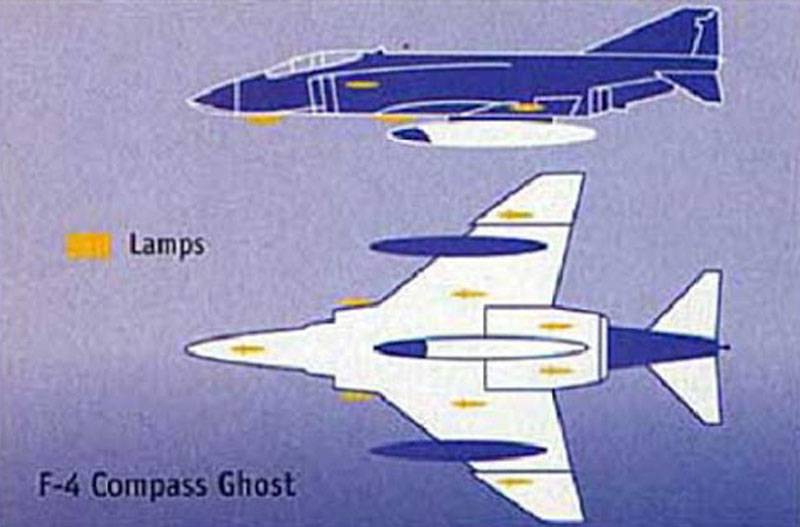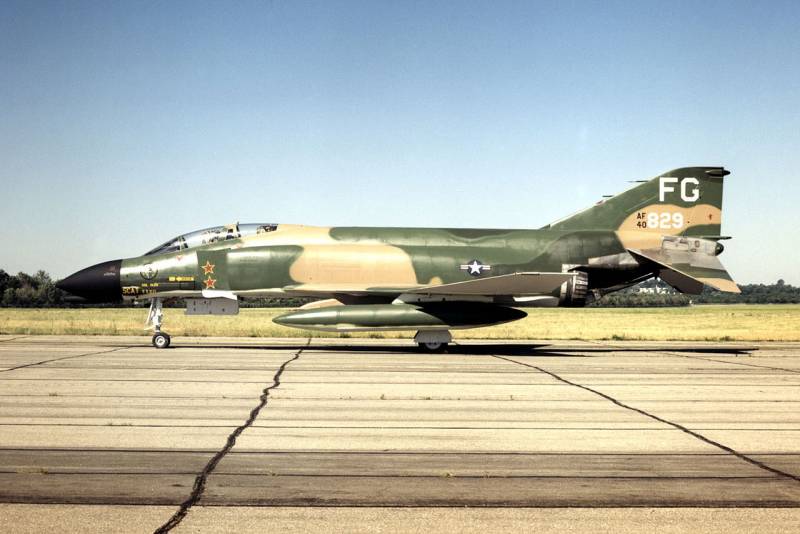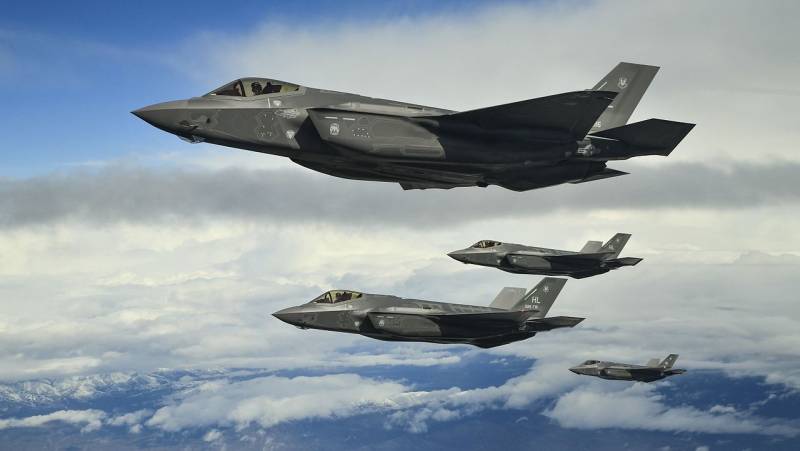Active light camouflage system Compass Ghost (USA)
During World War II, the interests of the Marine aviation The US Navy was developing the Yehudi Lights light camouflage system, which made it possible to hide the aircraft against the background of a bright sky and reduce the visibility range. However, the end of the war and the widespread use of radar made such a development useless. The idea of light-hiding aircraft returned after several decades, based on the experience of the Vietnam War.
Progress and regress
During the Vietnam War, the main means of detecting enemy aircraft were land-based, ship-based and air-based radars. However, with all its advantages, modern and progressive radars could not completely replace the visual detection method. So, fighter pilots in search of enemy aircraft still had to turn their heads and use observation devices such as "Eye Mk 1".
In the course of numerous air battles, it was noticed that the Vietnamese MiG-17 or MiG-21 fighters have an unusual advantage over the American F-4 Phantom II. With their smaller dimensions and cross-section, such aircraft turned out to be less visible to the naked eye. The American Phantom was larger and also left a noticeable trail of smoke. Accordingly, the Vietnamese pilot had a chance to notice the enemy earlier and successfully build an attack.
For some time, such questions remained without much attention. It was not until 1973 that the Pentagon launched the Compass Ghost research program, which aimed to reduce the optical visibility of the production F-4. The Compass Ghost program was considered as a potential part of larger promising projects - its results could be used both to modernize existing equipment and to develop completely new ones.
The main requirement for the "Circular Ghost" was to reduce the optical signature from all angles. For this, we decided to apply the basic ideas of the Yehudi Lights project - but at a new technical level.
Ideas and their implementation
It was established quite a long time ago that any aircraft in daytime conditions looks like a dark spot against the background of a bright sky. Lightening the color schemes did not give the desired result, and therefore had to use "active" methods. The Yehudi Lights project envisaged equipping the frontal projection of the aircraft with a set of lights of a given brightness, directing the light flux forward.
The artificial light had to merge with natural light and thereby masked the aircraft, reducing the distance of its detection from the front hemisphere. All this has been confirmed by a series of tests.

The Circular Ghost was based on the same ideas, but revised towards improvement. So, it was proposed to place the illumination lights not only on the frontal projection, but also on other surfaces of the aircraft. This made it possible to provide camouflage from different angles and gave obvious advantages over the "Yehudi Lights".
For the Compass Ghost, a special elongated canopy was developed, suitable for mounting on the fuselage and wings of an F-4 fighter. Together with the lanterns, a control system was used to maintain the power of the lanterns at the level of natural light.
The project involved the installation of nine lanterns. Five were installed on the fuselage: one under the nose, two on the sides of the air intakes and two under the nacelles. Four more products were fixed under the wing - at the level of the center section and the raised tip. The active camouflage was supplemented with a camouflage paint. The upper surfaces of the aircraft were to be painted blue, the lower surfaces gray.
Justifying the name of the system, the lanterns shone down and to the sides at the same time. Their light did not completely cover all the projections of the aircraft, but created characteristic light spots on them. Combined with the new paint job, the Compass Ghost was supposed to blur the plane's outline and distort its proportions. Thus, instead of an F-4 fighter, the enemy had to observe a smaller aircraft in the sky or even a strange set of colored spots.
Practical results
Also in 1973, McDonnell Douglas converted the existing F-4 fighter into a flying laboratory. The plane was repainted, and also equipped with lanterns, a control system, etc. In this form, he went out for tests, during which it was planned to carry out observations and measurements.
During the tests, the flying laboratory performed flights at different altitudes and speeds on different courses. On the ground were observers with various optical means, whose task was to detect the aircraft at the maximum possible range. Then a comparison was made between the detection ranges of the aircraft with the camouflage system turned off and on.
Tests have confirmed the deterioration of visibility from the front and side hemispheres. The same effect was observed from a light bottom with lanterns. On average, the new paintwork and Compass Ghost reduced the visual detection range by 30% in different weather conditions - with different levels of natural light, clouds, etc.
However, depending on the optics used, the detection range, even with the lights on, reached several miles. In addition, the "Circular Ghost" could not hide the characteristic "exhaust" of the engines. All of this showed that the lantern system and new paintwork alone were not sufficient to protect aircraft.
Project without prospects
The developments on the Compass Ghost theme were of great interest in the context of the further development of tactical aviation, and it was planned to take them into account when creating new aircraft. In parallel, research was conducted on the topic of stealth for radar and infrared detection equipment. All this eventually led to the creation of the modern concept of "stealth" and its main solutions.
Based on the results of various studies, it was decided to focus efforts on countering radar, and active light camouflage was considered unnecessary. However, this did not exclude the need to search for optimal coatings and paint schemes. By the end of the seventies, all work on lighting systems was stopped due to the lack of real prospects and interest from the customer.
In the future, new attempts were made to create camouflage illumination, incl. successful in terms of technology and performance. The aircraft literally disappeared at the end of the runway and reappeared only on the glide path. However, these developments did not interest the military - for the same reasons as in the mid-forties.
The only real result of the Compass Ghost project was the appearance of a new paint for aircraft. The combination of shades of gray in itself reduced the fighter's visibility compared to the standard green spotted camouflage. Later, the "Ghost" was spread in the US Air Force.
Failure of direction
All American combat aircraft light camouflage projects have proven their potential, but have not produced real results. The Yehudi Lights project was closed in the mid-forties, and work on the Compass Ghost began and finished three decades later. It is curious that these projects were united not only by the main idea, but also by the main reason for the failure.
Yehudi Lights appeared late enough. When this system was ready, radars became widespread, which reduced the value of optical systems. In the early seventies, the military again became interested in light camouflage, but by the middle of the decade, they again showed increased attention to radar - and the means of protection against it.
As a result, the "Circular Ghost" remained in a single copy. Active optical camouflage retained the status of a technical curiosity without real practical prospects. Technologies for reducing radar and infrared visibility received development, and in the field of optical camouflage, henceforth, they only managed to use camouflage colors.


Information